House dust mites as mange mites - Comment and review
Evolutionary studies place the house dust mite (HDM) and the mange mite as close parasitic relatives. For the HDM the change to scavenger happened about 80 million years ago, but in making the change it retained its old lifestyle and a parasitic-like enzyme similar to the enzyme made by the mange mite. Perhaps this similarity is why so many people are sensitive or allergic to the HDM, because their alert immune systems have mixed the mites together. Many immune reactions indicate this is the case.

Evidence:
The mange mite of this review lives in colonies under the scabbed sores of sheep enjoying high humidity conditions of the wool. The colony feeds on the liquid produced by sores that are the result of a progressive and intense allergic dermatitis. Once it was thought that the mite pierced the skin of its host with its mouth in order to feed, but that thinking has now changed. Research has found that enzymes in the mite's dropping cause an intense irritation on the animal's skin resulting in inflammation, scabs, discolouration of thickened skin, wounds open to bacteria, and loss of wool. Sores, if left unattended can cause a progressive and intense allergic dermatitis and threaten the health of the animal. In perfect breeding conditions a female mange mite can produce 50 to 100 eggs in its lifetime. The egg will progress adulthood in approximately 11 to 19 days, with adults living for up to 40 days. Unless disturbed the mite will spend its entire life feeding on one animal.
The house dust mite shares many of its characteristics with the sheep mange mite. It lives in colonies, with a complete life expectancy of approximately 3 months. Both mites produce digestive enzymes in order to feed. Many are transferred into their droppings and known to cause irritation or allergic reactions. The house dust mite and sheep scab mites need warm humid conditions to thrive.
Here's the difference! The house dust mite has evolved to become a scavenger, a clever move by the mite, because it no longer had to rely on one host for food. As a scavenger the mite feeds on organic debris found in dust, including decaying old skin scales covered in yeasts, bacteria, and fungi. It will also eat wheat and corn flour, dead mites, plant fibres, pollen, dog food etc. In order to digest this varied diet, the mite has developed an array of enzymes to tackle the job.
One of the most powerful of the mite’s enzymes has an action that has been described as similar to a meat tenderiser used in the food industry. It acts by dissolving the 'glue' that binds delicate epithelial cells together, most notably in the respiratory system. This HDM enzyme shares its characteristics and action with an enzyme from the sheep mange mite. Based on this, and the similarity in the mite’s lifestyles, it is not unreasonable to draw the conclusion that house dust mites were once mange mites, but in making the move to scavenger retained its old lifestyle and parasitic-like enzyme.
Published research in veterinary and medical entomology that brings this concern and report forward.
Notes:
- Dermatophagoides pteronyssinus - HDM and its enzyme/allergen Der p1
- Psoroptes ovis - P ovis and its enzyme/allergen Pso o1
Is Permanent Parasitism Reversible? – Critical Evidence from Early Evolution of House Dust Mites Pavel B Klimov, Barry OConnor, Systematic Biology, Vol. 62, Issue 3, 2013, p 411-423
The effect of Psoroptes ovis infestation on ovine epidermal barrier function, Stoeckli et al. ‘Veterinary Research’, 2013: 44 Article 11 “the surface-living mite deposits excretory and secretory products containing homologues of known house dust mite (HDM) allergens and enzymes on to the stratum corneum.” [Der p1 & Der p3]
A genomic analysis and transcription atlas of gene expression in Psoroptes ovis reveals feeding- and stage-specific patterns of allergen expression. Burgess et al, BMC Genomics 20, 756 (2019) Note: In the paper’s concluding remarks. … Stage-specific allergen expression was demonstrated for a number of known P. ovis allergens, including the major mite allergen Pso o 1 (a homologue of the HDM allergen Der p 1)
Microfloral diversity of cultured and wild strains of Psoroptes ovis infesting sheep. Hogg J C, Lehane M J, Parasitology, 2001, 123, 441-446
Allergens and their role in the allergic immune response, Thomas A E Platte-Mills Judith A Woodfolk, Immunological Reviews, 2011, Vol 242, Issue 1p 51-68
Protease allergens as initiators-regulators of allergic inflammation. SOH et al, 'Allergy' 2023;78: 1148-1168
‘Dust Mites’, Matthew J Colloff, 2009, Csiro Publishing, ISBN 0643102507
‘House dust mites as potential carriers for IgE sensitization to bacterial antigens’, Dzoro S et al, ‘Allergy’, 2018; 73:115-124

